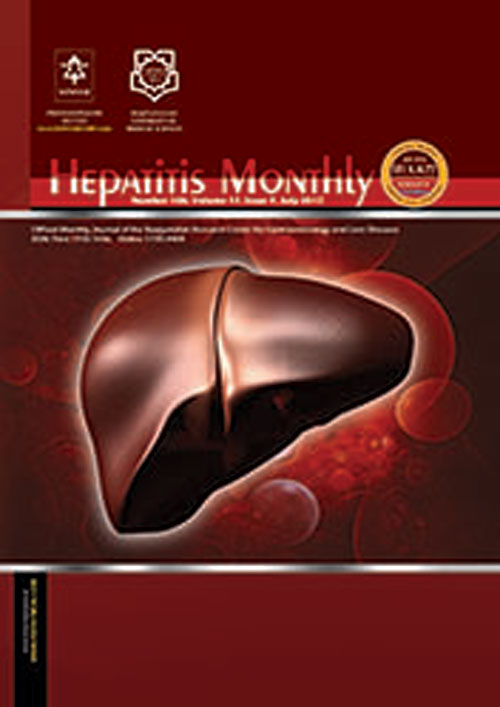فهرست مطالب

Hepatitis Monthly
Volume:19 Issue: 6, Jun 2019
- تاریخ انتشار: 1398/04/01
- تعداد عناوین: 2
-
-
Page 1ContextThe aim of this meta-analysis was to evaluate the efficacy and safety of glucocorticoid plus conventional therapy in hepatitis B-related liver failure.Evidence AcquisitionA systematic search was performed in PubMed, Embase, the Cochrane library, China National Knowledge Infrastructure, Wanfang database, and Google Scholar. The primary outcome was improvement in the mortality rate and the secondary outcome was the incidence of complications. Pooled data were based on the fixed-effect model.ResultsTen studies with 891 patients were included in the meta-analysis. Glucocorticoid plus conventional therapy (OR = 3.98, 95% CI: 2.80 - 5.66; P = 0.000) was superior to conventional treatment alone and reduced the mortality rate (OR = 0.38, 95% CI [0.20, 0.74], P = 0.004). Moreover, the incidence of complications, such as hepatic encephalopathy (OR = 0.34, 95% CI [0.19, 0.60], P = 0.000), hepatorenal syndrome (OR = 0.22, 95% CI [0.10, 0.47], P = 0.000), electrolyte imbalance (OR = 0.27, 95% CI [0.12, 0.62], P = 0.002), and ascites (OR = 0.50, 95% CI [0.28, 0.90], P = 0.021), were reduced. No statistically significant differences were found between the two groups in terms of lung infection (OR = 0.76, 95% CI [0.27, 2.10], P = 0.595), gastrointestinal bleeding (OR = 0.48, 95% CI [0.23, 1.00], P = 0.050), and bacterial peritonitis (OR = 0.70, 95% CI [0.31, 1.58], P = 0.396).ConclusionsOur meta-analysis suggests that glucocorticoid plus conventional treatment reduced the incidence of complications. Thus combination therapy could be an effective and safe approach in treating patients with hepatitis B-related liver failure.Keywords: Glucocorticoids_Liver Failure_Hepatitis B Virus_Meta-Analysis
-
Page 2ObjectivesHepatocellular adenoma (HCA) is a tumor with heterogenous molecular pathogenesis and varying malignant potential. Subclassification of HCAs is one of the important issues for the management decision to perform surgery or to follow up the patient. Iran is in intermediate status regarding the incidence of hepatocellular carcinoma, and on the other hand, incidence of viral precursors especially hepatitis B is decreasing, so it can be important to know the frequency of premalignant subtypes of liver cell adenomas in Iran.MethodsDuring the study period (10 years from 2008 to 2018) 40 cases of HCA (35 female and 5 males) were retrieved from the archives of the pathology departments of the affiliated hospitals of Shiraz University of Medical Sciences. The diagnosis was confirmed and the best paraffin block was used for IHC staining for liver fatty acid binding protein (LFABP), glutamine synthetase (GS), β-catenin and serum amyloid A (SAA). Histologic findings were also recorded. In the mean time, clinical charts of the patients were reviewed and clinicopathologic findings were compared.ResultsThe most common subtype in our cases was hepatocyte nuclear factor-1α inactivated and the least common was β-catenin activated subtype. We didn’t find any cases of mixed subtype. Inflammatory subtype was seen in 10% of the cases. Another 10% of our cases were unclassified because all of the IHC markers were negative.ConclusionsOur results confirmed that immunohistochemistry should be routinely performed to subclassify HCAs. We also showed that frequencies of subtypes differ according to the studied population. For our population (Middle East or west Asia) HCAs with malignant potential are the least common.Keywords: Liver Cell Adenoma, Immunohistochemistry, Classification

